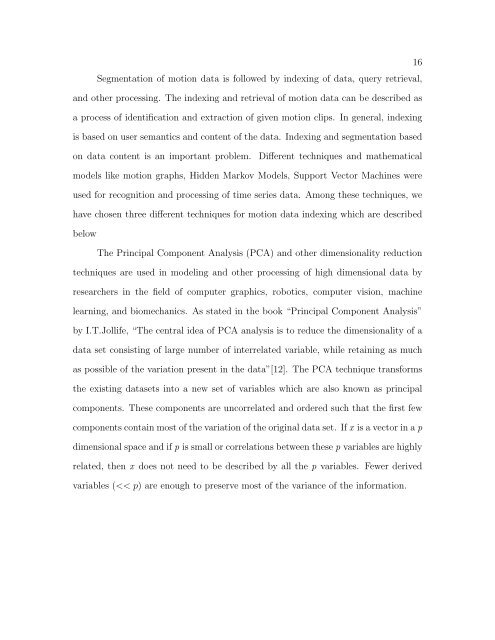A COMPARISON AND EVALUATION OF MOTION INDEXING ...
A COMPARISON AND EVALUATION OF MOTION INDEXING ...
A COMPARISON AND EVALUATION OF MOTION INDEXING ...
Create successful ePaper yourself
Turn your PDF publications into a flip-book with our unique Google optimized e-Paper software.
Segmentation of motion data is followed by indexing of data, query retrieval,<br />
and other processing. The indexing and retrieval of motion data can be described as<br />
a process of identification and extraction of given motion clips. In general, indexing<br />
is based on user semantics and content of the data. Indexing and segmentation based<br />
on data content is an important problem. Different techniques and mathematical<br />
models like motion graphs, Hidden Markov Models, Support Vector Machines were<br />
used for recognition and processing of time series data. Among these techniques, we<br />
have chosen three different techniques for motion data indexing which are described<br />
below<br />
The Principal Component Analysis (PCA) and other dimensionality reduction<br />
techniques are used in modeling and other processing of high dimensional data by<br />
researchers in the field of computer graphics, robotics, computer vision, machine<br />
learning, and biomechanics. As stated in the book “Principal Component Analysis”<br />
by I.T.Jollife, “The central idea of PCA analysis is to reduce the dimensionality of a<br />
data set consisting of large number of interrelated variable, while retaining as much<br />
as possible of the variation present in the data”[12]. The PCA technique transforms<br />
the existing datasets into a new set of variables which are also known as principal<br />
components. These components are uncorrelated and ordered such that the first few<br />
components contain most of the variation of the original data set. If x is a vector in a p<br />
dimensional space and if p is small or correlations between these p variables are highly<br />
related, then x does not need to be described by all the p variables. Fewer derived<br />
variables (
















